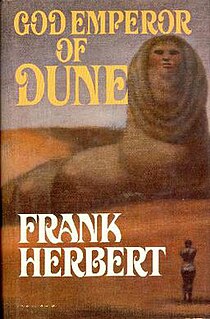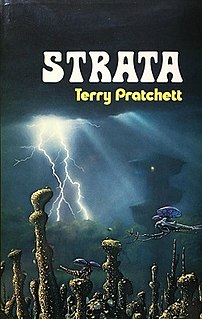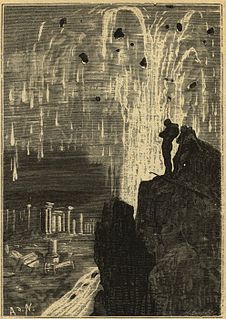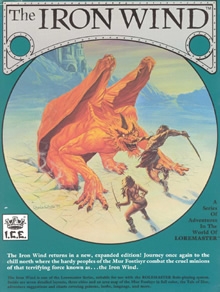
The Drake equation is a probabilistic argument used to estimate the number of active, communicative extraterrestrial civilizations in the Milky Way Galaxy.

God Emperor of Dune is a science fiction novel by Frank Herbert published in 1981, the fourth in his Dune series of six novels. It was ranked as the No. 11 hardcover fiction best seller of 1981 by Publishers Weekly.
The Hainish Cycle consists of a number of science fiction novels and stories by Ursula K. Le Guin. It is set in a future history in which civilizations of human beings on planets orbiting a number of nearby stars, including Terra ("Earth"), are contacting each other for the first time and establishing diplomatic relations, setting up a confederacy under the guidance of the oldest of the human worlds, peaceful Hain. In this history, human beings did not evolve on Earth but were the result of interstellar colonies planted by Hain long ago, which was followed by a long period when interstellar travel ceased. Some of the races have new genetic traits, a result of ancient Hainish experiments in genetic engineering, including people who can dream while awake, and a world of androgynous people who only come into active sexuality once a month, not knowing which sex will manifest in them. In keeping with Le Guin's style, she uses varied social and environmental settings to explore the anthropological and sociological outcomes of human evolution in those diverse environments.

Apocalyptic and post-apocalyptic fiction is a subgenre of science fiction, science fantasy, dystopia or horror in which the Earth's civilization is collapsing or has collapsed. The apocalypse event may be climatic, such as runaway climate change; astronomical, such as an impact event; destructive, such as nuclear holocaust or resource depletion; medical, such as a pandemic, whether natural or human-caused; end time, such as the Last Judgment, Second Coming or Ragnarök; or more imaginative, such as a zombie apocalypse, cybernetic revolt, technological singularity, dysgenics or alien invasion.

Strata is a 1981 science fiction comedy novel by Terry Pratchett. It is one of Pratchett's first novels and one of the few purely science fiction novels he wrote, along with The Dark Side of the Sun and The Nome Trilogy.

The Majipoor series is a series of novels and stories by American writer Robert Silverberg, set on the planet Majipoor. The setting is a mixture of science fiction and fantasy elements.
The idea of self-replicating spacecraft has been applied—in theory—to several distinct "tasks". The particular variant of this idea, applied to the idea of space exploration, is known as a von Neumann probe, after mathematician John von Neumann, who originally conceived of it. Other variants include the Berserker and an automated terraforming seeder ship.
The Noon Universe is a fictional future setting for a number of hard science fiction novels written by Arkady and Boris Strugatsky. The universe is named after Noon: 22nd Century, chronologically the first novel from the series.
Mary Rosalyn Gentle is a UK science fiction and fantasy author.
The zoo hypothesis speculates on the assumed behavior and existence of technologically advanced extraterrestrial life and the reasons they refrain from contacting Earth. It is one of many theoretical explanations for the Fermi paradox. The hypothesis states that alien life intentionally avoids communication with Earth to allow for natural evolution and sociocultural development, and avoiding interplanetary contamination, similarly to people observing animals at a zoo. The hypothesis seeks to explain the apparent absence of extraterrestrial life despite its generally accepted plausibility and hence the reasonable expectation of its existence. A variant on the zoo hypothesis suggested by the former MIT Haystack Observatory scientist John Allen Ball, is the laboratory hypothesis, where humanity is being subjected to experiments, with Earth being a giant laboratory.

The Saga of Seven Suns is a series of seven space opera novels by American writer Kevin J. Anderson, published between 2002 and 2008. The books are set in a not-too-distant future where humans have colonized a number of other planets across the galaxy, thanks in part to technological assistance from an ancient alien race, the Ildirans. The series chronicles the universe-spanning war that erupts when humans inadvertently ignite the fury of a hidden empire of elemental aliens known as the hydrogues. Internal conflict is sparked within both the human and Ildiran empires as other ancient elemental races reappear to renew their own ancient war with the hydrogues.

The island of Atlantis has often been depicted in literature, television shows, films and works of popular culture.
The Helliconia trilogy is a series of science fiction books by British writer Brian W. Aldiss, set on the Earth-like planet Helliconia. It is an epic chronicling the rise and fall of a civilisation over more than a thousand years as the planet progresses through its incredibly long seasons, which last for centuries.
The Alliance–Union universe is a fictional universe created by American writer C. J. Cherryh. It is the setting for a future history series extending from the 21st century into the far future.
The planetary systems of stars other than the Sun and the Solar System are a staple element in many works of the science fiction genre.

City of the Chasch is a science fiction novel by American writer Jack Vance, the first in the adventure tetralogy Planet of Adventure. It follows the attempts of a man stranded on the distant planet Tschai to return to Earth.

Shadow World is a high-fantasy campaign setting situated on the fictional planet of Kulthea. Originally produced for the Rolemaster role-playing game system, Shadow World is equally suited for the HARP Role-playing system, published since 2003. The setting blends traditional fantasy elements, such as elves, dwarves, and magic, with science fiction, including such elements as space and time travel, and, to a degree, futuristic technology.

Ancient astronauts have been addressed frequently in science fiction and horror fiction. Occurrences in the genres include:

Dying Earth is a subgenre of science fantasy or science fiction which takes place in the far future at either the end of life on Earth or the end of time, when the laws of the universe themselves fail. Themes of world-weariness, innocence, idealism, entropy, (permanent) exhaustion/depletion of many or all resources, and the hope of renewal dominate.
Golden Witchbreed is a novel by Mary Gentle published in 1983.










